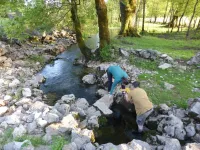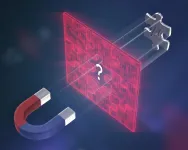(Press-News.org) A key portion of MIT's campus overlaps with Kendall Square, the bustling area in East Cambridge where students, residents, and tech employees scurry around in between classes, meetings, and meals. Where are they all going? Is there a way to make sense of this daily flurry of foot traffic?
In fact, there is: MIT Associate Professor Andres Sevtsuk has made Kendall Square the basis of a newly published model of pedestrian movement that could help planners and developers better grasp the flow of foot traffic in all cities.
Sevtsuk's work emphasizes the functionality of a neighborhood's elements, above and beyond its physical form, making the model one that could be used from Cambridge to Cape Town.
"This model allows us to estimate how many pedestrian journeys are likely to occur," Sevtsuk says. "It also forecasts trip distribution. That depends directly on what's available around pedestrians and how many destinations they can access on foot."
Sevtsuk's model could help fill a void in urban planning. It is normal for a traffic impact assessment (TIA) report to be required for new developments, estimating automobile traffic that the project is likely to create. But there is no standard equivalent for pedestrian traffic, leaving most officials and planners who make decisions about urban projects with greater uncertainty.
In short, counting pedestrians can help pedestrians count.
"There's this whole history of treating [automobile] traffic numerically," says Sevtsuk, "Every road investment is accompanied by a cost-benefit analysis. But those benefits are geared to moving around in cars. The people around the table who have numbers are traffic engineers. Cities have great data on vehicular networks, but we know very little about sidewalks in most cities."
The paper presenting the model, "Estimating Pedestrian Flows on Street Networks," appears in the Journal of the American Planning Association. Sevtsuk, the sole author, is the Charles and Ann Spaulding Career Development Associate Professor of Urban Science and Planning at MIT, and director of MIT's City Form Lab.
Bustling Main Street
The model itself draws upon network analysis, regarding most pedestrian trips as functional journeys between various origins and destinations: homes, offices, subway stops, restaurants, and other amenities. Sevtsuk placed a maximum radius on most trips and allowed for a "detour ratio" of up to 15 percent, meaning that pedestrian journeys in the model can go farther than the shortest path to get from one point to another.
To acquire data for the model, Sevtsuk obtained property-level data from the city and had observers count pedestrians on 60 street segments in Kendall Square for calibration purposes (before the Covid-19 pandemic) during two times of the day: a midday period from 12 to 2 p.m. and an evening rush-hour period from 4 to 8 p.m.
Among other things, Sevtsuk and his research assistants found that the average of these Kendall Square street segments had 872 pedestrians on it during the midday period, and 1,711 during the evening time slot. Kendall Square's Main Street -- which features a subway station, many MIT buildings, and offices for Google and Amazon, among other firms -- averaged a neighborhood-high 11,311 pedestrian trips during the four-hour evening period.
"We have to have real-world data to calibrate the model, and that's what puts us into a ballpark of accurate estimates on all streets," Sevtsuk says. "The representative sample only has to occur on some streets. But once it's calibrated on those 60 streets, the estimates are good to go for a whole lot more streets -- hundreds or thousands of streets can be estimated."
A tool for the drawing board, too
As Sevtsuk emphasizes, the model could be applied to almost any urban setting, and not just locations physically resembling Kendall Square. Given destinations to walk to and decent street conditions to connect them, people will walk around all kinds of neighborhoods.
"The estimates are not just comparatives from some similar places," Sevtsuk says. "They are directly estimated trips from specific buildings to other specific buildings nearby, depending on their uses."
Granted, the study did generate a number of particular observations about Kendall Square, where about 40 percent of workers and students appear to be walking to a lunch venue every day.
But more broadly, Sevtsuk emphasizes, the model could also be integrated into urban planning to help shape developments still on the drawing board in multiple ways -- to estimate pedestrian flows, to help with zoning decisions, and to make sure retail frontages are in places with significant pedestrian flow, among other things.
"What's particularly useful is it can be applied not just to existing areas like Kendall, but also newly planned places," Sevtsuk notes. "Even if we were planning a new area, just by knowing what the built configuration of the future development will be, and what land uses it may contain, we can have an educated forecast about what the pedestrian flows will look like."
INFORMATION:
Additional background
Paper: "Estimating Pedestrian Flows on Street Networks"
https://www.tandfonline.com/doi/abs/10.1080/01944363.2020.1864758?src=&journalCode=rjpa20
A new scientific discovery in Australia by Flinders University has recorded for the first time how ghost currents and sediments can 'undo' the force of gravity.
The new theory, just published in the Journal of Marine Systems, helps explain obscure events in which suspended sediment particles mysteriously move upward, not downward, on the slope of submarine canyons of the deep sea.
While this activity seems to contradict the laws of gravity, Flinders University physical oceanographer Associate Professor Jochen Kaempf has found an answer, devising the first scientific explanation of the observed upslope sediment transport.
"To put it simply, the vehicle of this transport are currents that, while carrying ...
Many long for a return to a post-pandemic "normal," which, for some, may entail concerts, travel, and large gatherings. But how to keep safe amid these potential public health risks?
One possibility, according to a new study, is dogs. A proof-of-concept investigation published today in the journal PLOS ONE suggests that specially trained detection dogs can sniff out COVID-19-positive samples with 96% accuracy.
"This is not a simple thing we're asking the dogs to do," says Cynthia Otto, senior author on the work and director of the University of Pennsylvania School of Veterinary Medicine Working Dog Center. "Dogs have to ...
Do freshwater snails make good tennis players? One of them certainly has the name for it.
Enter Travunijana djokovici, a new species of aquatic snail named after famous Serbian tennis player Novak Djokovic.
Slovak biospeleologist Jozef Grego and Montenegrin zoologist Vladimir Pesic of the University of Montenegro discovered the new snail in a karstic spring near Podgorica, the capital of Montenegro, during a field trip in April 2019. Their scientific article, published in the open-access, peer-reviewed journal Subterranean Biology, says they named it after Djokovic "to acknowledge his inspiring enthusiasm and energy."
"To discover some of the world's rarest animals that inhabit the unique underground habitats of the Dinaric karst, to reach inaccessible cave and spring habitats ...
WASHINGTON (April 15, 2021) -- Clusters of a virus known to cause stomach flu are resistant to detergent and ultraviolet disinfection, according to new research co-led by END ...
Since the 1970s, the Standard Model of Physics has served as the basis from which particle physics are investigated. Both experimentalists and theoretical physicists have tested the Standard Model's accuracy, and it has remained the law of the land when it comes to understanding how the subatomic world behaves.
This week, cracks formed in that foundational set of assumptions. Researchers of the "Muon g-2" collaboration from the Fermi National Accelerator Laboratory (FNAL) in the United States published further experimental findings that show that muons--heavy subatomic relatives of electrons--may have a larger "magnetic moment" than earlier Standard Model estimates had predicted, indicating that an unknown particle or force might be influencing ...
The DNA molecule is not naked in the nucleus. Instead, it is folded in a very organized way by the help of different proteins to establish a unique spatial organization of the genetic information. This 3D spatial genome organization is fundamental for the regulation of our genes and has to be established de novo by each individual during early embryogenesis. Researchers at the MPI of Immunobiology and Epigenetics in Freiburg in collaboration with colleagues from the Friedrich Mischer Institute in Basel now reveal a yet unknown and critical role of the protein HP1a in the 3D genome re-organization after fertilisation. The study published in the scientific journal Nature identifies HP1a as an epigenetic regulator that is involved in establishing ...
Leesburg, VA, April 15, 2021--A Scientific E-Poster to be presented at the 2021 ARRS Virtual Annual Meeting found that as the United States Medical Licensing Examination (USMLE) Step 1 transitions from a numerical score to pass or fail--as early as January 2022--radiology residency program directors will likely rely on USMLE Step 2 Clinical Knowledge (CK) scores as an objective and standardized metric to screen applicants.
"However," wrote lead investigator Rebecca Zhang of the University of Maryland School of Medicine in Baltimore, "program directors remain unsure whether they will ...
Leesburg, VA, April 15, 2021--A Scientific E-Poster to be presented at the 2021 ARRS Virtual Annual Meeting found that in the setting of a high pretest probability of COVID-19 infection or with a quick turnaround of the rapid real-time reverse transcriptase-polymerase chain reaction (RT-PCR) COVID-19 test, a chest x-ray (CXR) scoring system may be used prospectively to predict patient outcomes.
"We developed an accurate and reliable tool for classifying COVID-19 severity, which can be used both at the attending chest radiologist and junior resident level. This study identifies the laboratory, clinical and radiographic data that predict important patient outcomes such as death, intubation, and the need for chronic renal replacement ...
Scientists of Tomsk Polytechnic University has conducted research on the 35ClO2 isotope and developed a mathematical model and software, which allow predicting characteristics by 10 folds more accurate than already known results. The research work was conducted by a research team of Russian, German and Swiss scientists. The research findings are published in the Physical Chemistry Chemical Physics (IF: 3,4; Q1) academic journal and listed as one of the best articles.
The ClO2 molecule is extremely important for medicine and biophysics, as well as for the Earth atmosphere. It is used in medicine for disinfection and ...
A study published this week in The Lancet Public Health examines how we can use our income assistance systems to address drug use and drug-related harm.
The study, led by University of British Columbia (UBC) medical sociologist Dr. Lindsey Richardson and conducted at the British Columbia Centre on Substance Use (BCCSU), tests whether varying the timing and frequency of income assistance payments can mitigate drug-related harms linked to the existing once-monthly payment schedule that is common across North America and Europe. Monthly synchronized income assistance payments have long been linked to considerable and costly increases in drug use and resulting harm, including overdose, hospital admission, treatment interruption and emergency service calls.
The study finds that varying when ...







